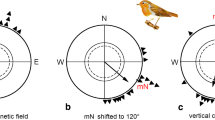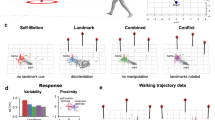Abstract
In principle, there are two strategies for navigating a straight course. One is to use an external directional reference and continually reorienting with reference to it, while the other is to infer body rotations from internal sensory information only. We show here that, while the first strategy will enable an animal or mobile agent to move arbitrarily far away from its starting point, the second strategy will not do so, even after an infinite number of steps. Thus, an external directional reference—some form of compass—is indispensable for ensuring progress away from home. This limitation must place significant constraints on the evolution of biological navigation systems. Some specific examples are discussed. An important corollary arising from the analysis of compassless navigation is that the maximum expected displacement represents a robust measure of the straightness of a path.
Similar content being viewed by others
References
Batschelet E (1981) Circular statistics in biology. Academic, London
Benhamou S, Sauvé J-P, Bovet P (1990) Spatial memory in large scale movements: efficiency and limitation of the egocentric coding process. J Theor Biol 145:1–12
Bovet P, Benhamou S (1988) Spatial analysis of animals’ movements using a correlated random walk model. J Theor Biol 131:419–433
Byers J (2001) Correlated random walk equations of animal dispersal resolved by simulation. Ecology 82(6):1680–1690
Capaldi EA, Smith AD, Osborne JL, Fahrbach SE, Farris SM, Reynolds DR, Edwards AS, Martin A, Robinson GE, Poppy GM, Riley JR (2000) Ontogeny of orientation flight in the honeybee revealed by harmonic radar. Nature 403(6769):537–540
Chittka L, Williams NM, Rasmussen H, Thomson JD (1999) Navigation without vision: Bumblebee orientation in complete darkness. Proc R Soc Lond B 266:45–50
Collett TS, Rees JA (1997) View-based navigation in hymenoptera: multiple strategies of landmark guidance in the approach to a feeder. J Comp Physiol A 181:47–58
Dacke M, Nilsson D-E, Scholtz C, Byrne M, Warrant EJ (2003) Animal behaviour: Insect orientation to polarized moonlight. Nature 424:33
Etienne AS, Maurer R, Berlie J, Reverdin B, Rowe T, Georgakopoulos J, Séguinot V (1998) Navigation through vector addition. Nature 396:161–164
Etienne AS, Maurer R, Séguinot V (1996) Path integration in mammals and its interaction with visual landmarks. J Exp Biol 199:201-209
Gallistel CR (1990) The Organisation of Learning. MIT Press, Cambridge
Görner P, Claas B (1985) Homing behavior and orientation in the funnel-web spider, Agelena labyrinthica. In: Barth FG (ed) Neurobiology of arachnids. Springer, Berlin, pp 275–297
Hartmann G, Wehner R (1995) The ant’s path integration system: a neural architecture. Biol Cybern 73:483–497
Ingemar JC (1991) Blanche—an experiment in guidance and navigation of an autonomous robot vehicle. IEEE Trans Robot Autom 7:193–204
Kareiva PM, Shigesada N (1983) Analyzing insect movement as a correlated random walk. Oecologia 56:234–238
McCulloch CE, Cain ML (1989) Analyzing discrete movement data as a correlated random walk. Ecology 70(2):383–388
Mantegna RN, Stanley HE (1994) Stochastic process with ultraslow convergence to a Gaussian: the truncated Lévy flight. Phys Rev Lett 73:2946–2949
Mardia KV (1972) Statistics of directional data. Academic, London
Mittelstaedt H, Mittelstaedt ML (1982) Homing by path integration. In: Papi F, Wallraff HG (eds) Avian navigation. Springer, Berlin, pp 290–297
Nahapetian B (1991) Limit theorems and some applications in statistical physics. Teubner, Leipzig, pp 22–23
Nossal R, Weiss G (1974) A descriptive theory of cell migration on surfaces. J Theor Biol 47:103–113
Rosenblatt M (1956) Remarks on some nonparametric estimates of a density function. Ann Math Stat 27:832–835
Seyfarth EA, Hergenröder R, Ebbes H, Barth FG (1982) Idiothetic orientation of a wandering spider: compensation of detours and estimates of goal distance. Behav Ecol Sociobiol 11:139–148
Shlesinger MF (1995) Comment on “Stochastic process with ultraslow convergence to a Gaussian: the truncated Lévy flight”. Phys Rev Lett 74:4959
Thrun S (1997) To know or not to know: on the utility of models in mobile robots. AI Mag 18:47–54
Viswanathan GM, Buldyrev SV, Havlin S, da Luz MGE, Raposo EP, Stanley HE (1999) Optimizing the success of random searches. Nature 401:911–914
Wehner R (1987) Spatial organization of foraging behavior in individually searching desert ants, Cataglyphis (Sahara Desert) and Ocymyrmex (Namib Desert). Behav Soc Insects (Experientia Supplementum) 54:15–42
Wehner R (1992) Arthropods. In: Papi F (ed) Animal homing. Chapman and Hall, London, pp 45–144
Wehner R (1994) The polarization-vision project: championing organismic biology. Fortschritte der Zoologie 39:103–143
Wiltschko W, Wiltschko R (2005) Magnetic orientation and magnetoreception in birds and other animals. J Comp Physiol A 191(8):675–693
Wittmann T, Schwegler H (1995) Path integration—a network model. Biol Cybern 73:569–575
Wolf H and Wehner R (2005) Desert ants compensate for navigation uncertainty. J Exp Biol 208:4223–4230
Zollikofer CPE (1994) Stepping patterns in ants. II. Influence of body morphology. J Exp Biol 192:107–118
Author information
Authors and Affiliations
Corresponding author
Rights and permissions
About this article
Cite this article
Cheung, A., Zhang, S., Stricker, C. et al. Animal navigation: the difficulty of moving in a straight line. Biol Cybern 97, 47–61 (2007). https://doi.org/10.1007/s00422-007-0158-0
Received:
Accepted:
Published:
Issue Date:
DOI: https://doi.org/10.1007/s00422-007-0158-0




